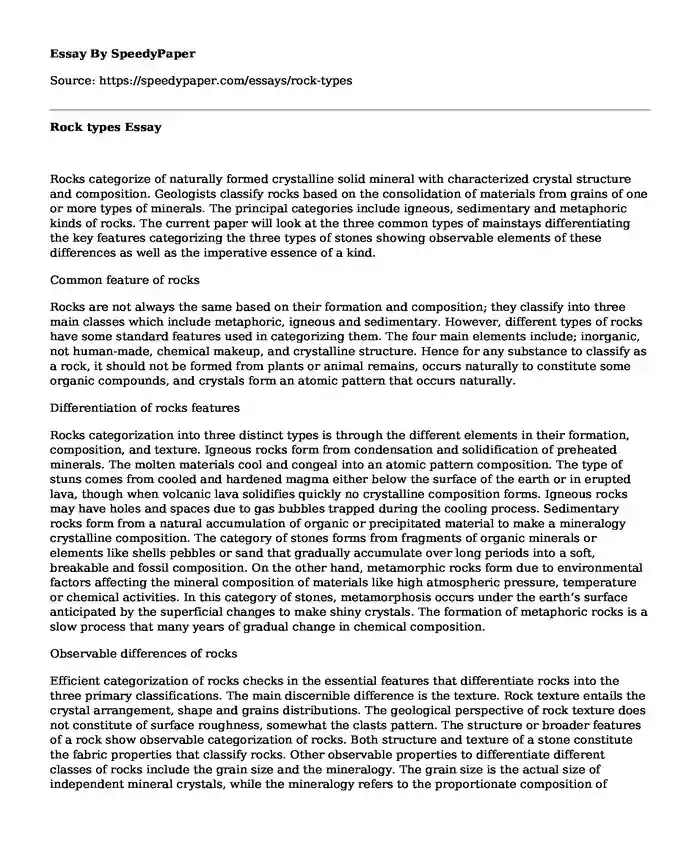
| Type of paper: | Essay |
| Categories: | Management Human resources Finance Medicine |
| Pages: | 3 |
| Wordcount: | 622 words |
Rocks categorize of naturally formed crystalline solid mineral with characterized crystal structure and composition. Geologists classify rocks based on the consolidation of materials from grains of one or more types of minerals. The principal categories include igneous, sedimentary and metaphoric kinds of rocks. The current paper will look at the three common types of mainstays differentiating the key features categorizing the three types of stones showing observable elements of these differences as well as the imperative essence of a kind.
Common feature of rocks
Rocks are not always the same based on their formation and composition; they classify into three main classes which include metaphoric, igneous and sedimentary. However, different types of rocks have some standard features used in categorizing them. The four main elements include; inorganic, not human-made, chemical makeup, and crystalline structure. Hence for any substance to classify as a rock, it should not be formed from plants or animal remains, occurs naturally to constitute some organic compounds, and crystals form an atomic pattern that occurs naturally.
Differentiation of rocks features
Rocks categorization into three distinct types is through the different elements in their formation, composition, and texture. Igneous rocks form from condensation and solidification of preheated minerals. The molten materials cool and congeal into an atomic pattern composition. The type of stuns comes from cooled and hardened magma either below the surface of the earth or in erupted lava, though when volcanic lava solidifies quickly no crystalline composition forms. Igneous rocks may have holes and spaces due to gas bubbles trapped during the cooling process. Sedimentary rocks form from a natural accumulation of organic or precipitated material to make a mineralogy crystalline composition. The category of stones forms from fragments of organic minerals or elements like shells pebbles or sand that gradually accumulate over long periods into a soft, breakable and fossil composition. On the other hand, metamorphic rocks form due to environmental factors affecting the mineral composition of materials like high atmospheric pressure, temperature or chemical activities. In this category of stones, metamorphosis occurs under the earth's surface anticipated by the superficial changes to make shiny crystals. The formation of metaphoric rocks is a slow process that many years of gradual change in chemical composition.
Observable differences of rocks
Efficient categorization of rocks checks in the essential features that differentiate rocks into the three primary classifications. The main discernible difference is the texture. Rock texture entails the crystal arrangement, shape and grains distributions. The geological perspective of rock texture does not constitute of surface roughness, somewhat the clasts pattern. The structure or broader features of a rock show observable categorization of rocks. Both structure and texture of a stone constitute the fabric properties that classify rocks. Other observable properties to differentiate different classes of rocks include the grain size and the mineralogy. The grain size is the actual size of independent mineral crystals, while the mineralogy refers to the proportionate composition of minerals especially in igneous rocks. More observable features could comprise of color, hardness, and gravity available in the petrographic description of a mainstay.
Importance of different types of rocks
Different rocks are of essence to mankind based on their categories. The different significance of rocks includes a good source of fuel and power like deriving natural gas, petroleum, and coal. Rocks are a source of extraction of valuable minerals like gold and diamond, salt extraction, water supply, tourist attraction, and ceramic use. Other significance of rocks based on the human utilization includes the formation of soil through disintegration, the source of cellular nutrients, construction, body detoxification using supplements, and a source of employment during extraction.
Works cited
Hamilton, W.R.; Woolley, A.R. & Bishop, A.C. "The Larousse Guide to Minerals, Rocks and Fossils" Larousse and Co. Inc., New York.
Cite this page
Rock types. (2022, Mar 31). Retrieved from https://speedypaper.com/essays/rock-types
Request Removal
If you are the original author of this essay and no longer wish to have it published on the SpeedyPaper website, please click below to request its removal:
- Marxism Today Essay Example for Everyone's Use
- Essay Example: Deep Learning for the Internet of Things with Edge Computing
- Business Law Questions - Free Essay Example
- Young Goodman Brown - Nathaniel Hawthorne Essay Example
- The Rosewood Film - Movie Review Essay Example
- Essay Sample: Targeting the Premium Dog Market
- Free Essay: the Philosophy of Science
Popular categories




